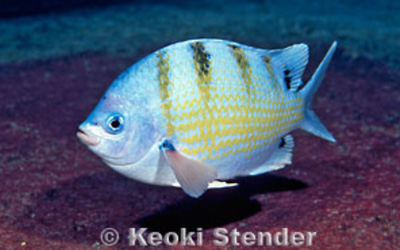Species of the Month – Pepeluali (February) 2023
Mamo
Abudefduf abdominalis | Hawaiian sergeant

Ka Hōʻike ʻAno - Description
- Endemic to Hawaiʻi with a greenish white coloring and 5 black bars.
- Their abdomen has a subtle yellow striping that can change in length and color
- They feed on plankton, limu (seaweed) and other marine organisms
- The Hawaiian name, Mamo, is a shortened version of maʻomaʻo or green that speaks to their greenish color
Citations: hawaiisfishes.com; wehewehe.org
Ka Laulā Kaianoho - Distribution
- Found throughout the Main Hawaiian Islands and Johnston Atoll
- From near-shore environments to 50m (164ft), usually in calm habitats
- They occur in deep waters and coral reefs with young often found in tidepools
Citation: Randall, 2007
Ka Waiwai Hoʻoilina - Cultural Significance
- Mamo is the name for the now extinct Hawaiian Honeycreeper (Drepanis pacifica)
- Mamo was also a preferred fish eaten by Hawaiian chiefs because of their softness. They were eaten raw or boiled.
- Other names for this fish are maʻomaʻo, mamamo, mao, and mamo pohole
Citations: bishopmuseum.org; ulukau.org; wehewehe.org
ʻIkepili Hoihoi - Interesting Fact
- Mālama ka mao kāne i ka pūnana hua, inā hoʻomakaʻu ʻia ka mao kāne e kekahi ʻano mea, haʻalele ʻo ia i kāna pūnana a ʻai koke ʻia nā hua mao e nā iʻa ʻē aʻe i ʻono i ka hua mao.
- The male Maomao guards its nest, if the male is frightened by something he will leave his nest and his eggs are quickly eaten by the other fish who like to eat Maomao eggs.
Citations: Kūʻula, 2003; ulukau.org



